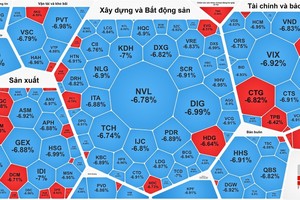 Prime Minister Pham Minh Chinh speaks at a recent meeting with HCMC's leaders. (Photo: VNA)
Prime Minister Pham Minh Chinh speaks at a recent meeting with HCMC's leaders. (Photo: VNA)
HCMC is the country’s economic powerhouse with a significant GDP contribution to the national budget, the PM said at a recent working session with municipal leaders.
Professor Tran Hoang Ngan, Director of the HCMC Development Research Institute, said the decision would help resolve a number of challenges related to road infrastructure, social security, healthcare, and other issues.
“If the city received a 1 percent increase in retained revenue, it would then have an additional VND2 trillion (US$86.748 million), and an increase of 5 percent would yield an additional VND10 trillion.”
Dr. Huynh The Du, public policy lecturer at Fulbright University, said the city needs to be highly competitive to attract large businesses, a highly skilled workforce, and well-off people compared to other cities in the region and in the world.
China, for example, has spent a lot of resources on big cities, he added.
At the working session, Nguyen Thanh Phong, Chairman of the municipal People’s Committee, proposed that the government approve the budget retention rate of 23 percent instead of the current 18 percent over the next five years.
“HCMC has one of the lowest budget retention rate of all cities in the world, and this should change,” Phong said. The city contributes 27 percent to the national budget, and has the lowest retention rate in the country.
In the first four months, the city posted a budget collection of VND140 trillion ($6 billion), up 15.7 percent year-on-year, Phong said.
The low budget retention rate has prevented the financial hub of HCMC from addressing traffic jams and school shortages.
With only 9 percent of Vietnam’s total population, the city contributes 24 percent of the country’s GDP.
Experts said the city does not have enough money to build more roads as the percentage of retained budget revenue is too low.
The city also needs 10,000 additional classrooms every half decade to keep pace with the population increase, with each classroom hosting a standard 30 students. It currently has to pack 40-60 students into a single room, they said.
Budget retention ratios for four other centrally-run cities - Hanoi, Hai Phong, Da Nang and Can Tho for the 2016-2020 period are 35, 78, 68, and 91 percent, respectively, far above HCMC.
According to the Department of Planning and Investment, the city’s total retail sales of goods and revenue from consumer services in the first four months was up 7.9 percent year-on-year.
The city’s Gross Regional Domestic Product (GRDP) reached VND329.6 trillion in the first quarter, up 4.58 percent year-on-year.
Professor Tran Hoang Ngan, Director of the HCMC Development Research Institute, said the decision would help resolve a number of challenges related to road infrastructure, social security, healthcare, and other issues.
“If the city received a 1 percent increase in retained revenue, it would then have an additional VND2 trillion (US$86.748 million), and an increase of 5 percent would yield an additional VND10 trillion.”
Dr. Huynh The Du, public policy lecturer at Fulbright University, said the city needs to be highly competitive to attract large businesses, a highly skilled workforce, and well-off people compared to other cities in the region and in the world.
China, for example, has spent a lot of resources on big cities, he added.
At the working session, Nguyen Thanh Phong, Chairman of the municipal People’s Committee, proposed that the government approve the budget retention rate of 23 percent instead of the current 18 percent over the next five years.
“HCMC has one of the lowest budget retention rate of all cities in the world, and this should change,” Phong said. The city contributes 27 percent to the national budget, and has the lowest retention rate in the country.
In the first four months, the city posted a budget collection of VND140 trillion ($6 billion), up 15.7 percent year-on-year, Phong said.
The low budget retention rate has prevented the financial hub of HCMC from addressing traffic jams and school shortages.
With only 9 percent of Vietnam’s total population, the city contributes 24 percent of the country’s GDP.
Experts said the city does not have enough money to build more roads as the percentage of retained budget revenue is too low.
The city also needs 10,000 additional classrooms every half decade to keep pace with the population increase, with each classroom hosting a standard 30 students. It currently has to pack 40-60 students into a single room, they said.
Budget retention ratios for four other centrally-run cities - Hanoi, Hai Phong, Da Nang and Can Tho for the 2016-2020 period are 35, 78, 68, and 91 percent, respectively, far above HCMC.
According to the Department of Planning and Investment, the city’s total retail sales of goods and revenue from consumer services in the first four months was up 7.9 percent year-on-year.
The city’s Gross Regional Domestic Product (GRDP) reached VND329.6 trillion in the first quarter, up 4.58 percent year-on-year.
























